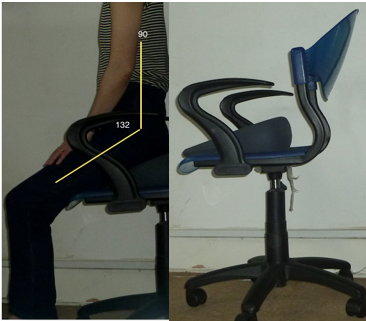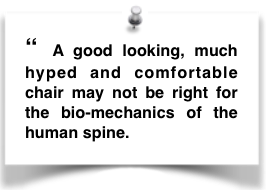OK. So you use a chair and are liable to backache. All this is very confusing and so what do you do? I am no longer in the business of giving advice to patients and organisations. However my interest in optimising chair design might allow me to offer some tips for users and patients (only).
Possible remediation.
If you have an expensive, top range chair or a cheap one, examine the section on how some of these relate to the 2T concept. A good chair can be modified to approach the advantages of the 2T CONCEPT (see 2T CONCEPT a full solution →’). This may help you modify your own chair.
- Disable the adjustment that allows the pelvic support to be above 20 cm above the seat (?Chewing gum) (see ‘Lumbar, pelvic/iliac support’)
- Arrange for the adjustment control to allow easy back & forward movement. Make the chair a 2T system – either reclined or forward but not intermediate. (Unstable intermediate mode→).
- Intermediate ranges should be unstable. They can be used as a rocking chair or as therapeutic exercise following an acute episode of backache/lumbago.
- In the upright mode the seat can be either tilted forward (see ‘The forward tilted seat), or arranged to take advantage of the pelvic support providing this is correctly modelled or a combination of both.
- Apart from chair height and head/foot-rest, adjustments should be set accordingly and then ignored or fixed.
- If you are buying, a back shop can show a number of models and advise but be aware that they are trying to sell you something and tend to feed you the manufacturers hype.
If your chair is really basic you may need some widgets. Possibilities are
- A wedged cushion on the seat which helps approximate to a ‘Forward Tilted Seat’ (FTS). See .Why? Mandal’s Homo sedens. The concept has been fully confirmed by research using pMRI scans. See short account below.
 One I assessed, from America ªSITTS Posture Cushions.) and wrote ” The seat pan is parallel to the floor (checked) but with some contouring that might add 2° . The hip angle is shown to be 132° which is close to the optimum angle (130°) determined by pMRI studies to avoid adverse movement of the Intervertebral disc contents (Smith FW et al. The Response of the Nucleus Pulposus of the Lumbar Intervertebral Discs to Functionally Loaded Positions. 2007;SPINE Volume 32, Number 14, pp 1508 –1512). See → Positional MRI
One I assessed, from America ªSITTS Posture Cushions.) and wrote ” The seat pan is parallel to the floor (checked) but with some contouring that might add 2° . The hip angle is shown to be 132° which is close to the optimum angle (130°) determined by pMRI studies to avoid adverse movement of the Intervertebral disc contents (Smith FW et al. The Response of the Nucleus Pulposus of the Lumbar Intervertebral Discs to Functionally Loaded Positions. 2007;SPINE Volume 32, Number 14, pp 1508 –1512). See → Positional MRI- The above confirms the views of AC Mandal which he advocated in his book (Mandal. AC., The Seated Man (Homo sedens). 1985. Dafnia Publications,) are confirmed. He advocated a seat that was tilted forward and down by 20-30° from the horizontal, allowing the hips to extend to 120-130˚ and the pelvis to tilt forward with the lower spinal joints adopting the correct, safe, lordotic posture.
- With the seat tilted forward, note that the user is not constrained by a backrest and is free to move, the lumbar lordosis is maintained by the pelvis being tilted forward. The versions with a steeper angle may have a problem with slippage. Now in 2018 since writing the above on an early version, new improved ones have been developed by SITTS. They look good and can be seen at https://www.kickstarter.com/projects/sittsperfect/sitts-cushions-a-natural-way-to-perfect-posture?ref=nav_search&result=project&term=sitts Or→ (http://www.sittsperfect.com)
- A backrest cushion that gives iliac support. Have a good look at the section here on iliac support that must not be higher than 20 cm above the seat and approximates as near as possible to the original Gorman model.
- My patients loved the ‘PostureRight’ cushion which was designed by my old St Thomas’ colleague, Dr Bernard Watkins.
- Various lumbar ‘Rolls’ are OK if correctly placed.
- I have a cheap (£1) and cheerful wire & net model which works moderately well.
Remember the importance of exercise & movement. Good Luck!
 There is plenty of well intentioned advice on backache to be found on the web. But please read this first (Sorry, hard work, I know) so that you can distinguish the rarely well informed from misinformation and hype, some that is frankly laughable. Just have a look at Google→.
There is plenty of well intentioned advice on backache to be found on the web. But please read this first (Sorry, hard work, I know) so that you can distinguish the rarely well informed from misinformation and hype, some that is frankly laughable. Just have a look at Google→.
The Hermann Miller account from being almost laughable is now good, probably as a result of being advised by Andersson, the Swedish scientist. I find the latest (2015) account too diffuse to be easily comprehensible and illustrates some retro models.
JD Gorman’s holistic/ chiropractic account can be seen at ‘Natural Joint mobility’.
Some is linked in Backache and GENERAL USERS→

